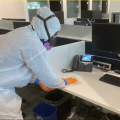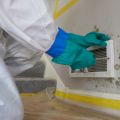Health Risks of Mold Spores

Mold is an extremely common problem in Florida homes, usually due to the humid environment and living habits, and therefore is a problem because of the health risks associated its spores. ServiceMaster by PWF Pinellas has technicians who are highly trained and have many years of experience in mold inspection and mold remediation.
ServiceMaster by PWF Pinellas is a mold removal company that can produce before-and-after results to validate the clean. You can be certain that all mold will be effectively removed and its return prevented, giving you complete peace of mind. Now, let’s be sure you understand mold.
Basic Facts About Mold
Here are some basic facts about mold from the experts at ServiceMaster Restore.
- Mold requires moisture and organic material to grow.
- Mold and mildew are often used interchangeably, but they are different. Mildew is a surface growth which appears white or gray, and is an early stage of mold. It easily develops on cardboard, books and fabric, but can often be wiped clean easily.
- Mold can appear greenish-gray, brownish-green, gray or black.
- Mold is propagated by spores, acting as seeds to create new colonies.
- Mold can grow in as little as 24 to 48 hours after a water damage event.
- After a flood, mold may grow in hidden places, including behind drywall, within insulation, on carpets or throughout the HVAC system.
- Mold inhibitors may be added to paint before painting to reduce the potential for mold growth.
Types Of Mold and How To Recognize Them
Mold comes in many different forms; in fact, according to the Centers for Disease Control and Prevention, there are probably tens of thousands of types of molds, if not more. Molds play an important role in breaking down leaves, plants, and trees. Mold can break down natural materials, like wood and leaves, which can damage the structure of your home.
Here are a few types of mold commonly encountered in various areas of a building:
Alternaria

- One of the more common molds found indoors and outdoors is Alternaria.
- Alternaria usually appears in areas that are damp like sinks and showers, or dark and dimly lit areas outside the home.
- Health problems associated with Alternaria include asthma attacks and allergic reactions.
Aspergillus

- Another indoor mold is Aspergillus.
- This mold is incredibly common and does minor damage to those who inhale it.
- Severe reactions include respiratory infections, allergic reactions and inflamed lungs.
Aureobasidium

- The Aureobasidium mold is most often found on wooden furniture, surfaces, painted walls and wallpaper as well as around windows and in caulk.
- If you notice a spotty substance that is pink and black in color in those areas, it’s probably this type of mold.
- Since Aureobasidum is so common, most people do develop allergic reactions to it and it has been known to cause more severe reactions than other molds.
Chaetomium

- Chaetomium mold is found in drywall that has experienced water damage.
- People typically identify their presence when they smell a musty or old odor in their homes.
Cladosporium

- Homeowners often find the Cladosporium mold inside both cool and warm areas like carpets, wood floorboards, wooden cabinet and older fabrics.
- Being around the Cladosporium mold can leave homeowners with breathing problems and respiratory issues.
Fusarium

- Fusarium is a mold that tends to grow in colder, wetter areas.
- The typical homes for Fusarium are carpeted areas and similar fabrics.
- Fusarium can cause standard allergic reactions as well as respiratory infections and inflammations.
How Does Mold Growth Start?
Not many people realize this, but mold is generally caused by lifestyle. Put simply, this means it is caused by the way we live in our homes these days. We cause a lot of moisture from:
- Cooking
- Boiling a kettle
- Bathing
- Showering
- Drying clothes
These are everyday activities, which in the summer months rarely cause an issue because we tend to open our windows and ventilate for long periods. However, when our windows are closed to retain AC, this prevents all the accumulated moisture from escaping, which quickly encourages mold to form.
Where Does Mold Grow in Buildings?
Homes that lack appropriate air ventilation, plus those with failing insulation can be more susceptible to dampness and mold. Those that are overcrowded can also be at a higher risk of mold, as are those in rental properties. Although those with existing health issues are at a greater risk of acquiring more from mold, exposure can also affect healthy people.
Mold commonly grows in/on/around:
- Wallpaper, flooring, behind wall tiles and on window frames
- Leaking radiators and pipes
- Leaking water in an inconspicuous spot means many won’t notice until the damage has already been done
- Flooded areas, and unless the mold is fast-growing, the damage may not be noticeable for years
Health Risks of Mold
While some mold species are harmless, some types produce allergens, irritants, and even toxic substances. Allergens are substances that can cause allergic reactions. These allergic reactions can stem from inhaling or touching mold or its spores.
Here are some allergic reactions that you can experience when you are affected by mold spores:
- Airway inflammation
- A sore throat
- Chest tightness
- Coughing
- Itchy eyes
- Long-standing or frequent sinusitis
- Nasal congestion
- Rash
- Redness of the eyes
- Runny nose
- Watery eyes
- Wheezing/shortness of breath
Prolonged exposure can cause chronic lung problems. Those who already suffer from asthma and allergies are more likely to have more severe symptoms when exposed to mold spores.
You can also suffer from serious pain and neurological symptoms, such as:
- Fatigue and weakness
- Frequent colds and flu
- Headaches and migraines
- Joint pain
- Muscle cramping, aches, and pains
- Numbness, tingling or tremors
- Persistent nerve pain
- Poor memory, brain fog, difficulty with focus
- Vertigo/Dizziness
The people most at risk for mold health concerns are:
- babies and children
- elderly people
- those with existing skin problems, such as eczema
- those with respiratory problems, such as allergies and asthma
- those with a weakened immune system
Structural Damage Caused by Mold
- As mentioned, mold thrives on organic matter such as cardboard and wood. As it grows on organic building materials, it first causes surface damage.
- Mold is often not the direct cause of structural damage, but is only a symptom of high moisture buildup.
- Combined with uneliminated moisture, mold will gradually deteriorate the organic material it grows on, causing rotting and eventually severe structural damage.
Why is Air Quality Testing Recommended?
Mold inspectors may recommend an air quality test to determine the type of mold growing in your structure and the degree of infestation. Moreover, whatever the type of mold present, the CDC recommends that mold should be removed immediately to prevent future growth.
If you do decide to pay for environmental sampling for molds, before the work starts, you should ask the consultants who will do the work to establish criteria for interpreting the test results. They should tell you in advance what they will do or what recommendations they will make based on the sampling results. The results of samples taken in your unique situation cannot be interpreted without physical inspection of the contaminated area or without considering the building’s characteristics and the factors that led to the present condition.
Centers for Disease Control and Prevention (CDC)
How to Prevent Mold Growth
- Ensure adequate airflow to reduce air humidity levels and condensation, as well as to not let rooms and walls become cold.
- Install and use appropriate ventilation, especially in damp areas such as bathrooms and kitchens.
- Ensure that the roof, pipes and window frames are watertight.
- Put lids on saucepans, dry/wash outside and avoid using paraffin or bottled gas heaters.
- Open the bedroom window for 15 minutes each morning.
- If you’re cooking, showering or bathing, open the window, put the fan on and close the door of the room you’re in.
- Dry wash outside if possible. Otherwise, hang laundry up in the bathroom, close the door and have the window open or a fan working continuously while it dries.
Mold and the spores it produces are a recognized health hazard. If the area affected by mold is less than 1 square meter and the growth is caused by condensation, you may be able to remove it on your own.
If the mold is a result of sewage backup or is one square meter or larger in size, you will need to contact a professional mold remediation company in Clearwater, Florida.
Fight Mold by Improving Home Air Flow
As excessive moisture is the primary driver of mold growth, adequate ventilation can effectively combat mold development while improving the home's indoor air quality. Here's how to improve home air flow:
Open windows and doors
- Improve airflow by opening some windows and doors when the weather permits.
- Opening doors or windows on opposite sides of the home creates a cross-ventilation that allows fresh air to enter, carrying excess humidity and moisture out with it.
- To encourage cross-ventilation, position a fan in or near a window, pointing inward into the living space.
Install fans
- Installing fans greatly improves the air circulation in the house.
- Place fans in your living spaces and in areas with increase moisture, such as bathrooms, kitchens and attics.
Utilize dehumidifiers
- Dehumidifiers reduce atmospheric moisture by drying out air and helping it circulate throughout the home, reaching target areas with poorer airflow or increased humidity, such as basements.
- Dehumidifiers are also energy-efficient as they can be used to focus on problem areas instead of operating an entire air conditioner.
How Quickly Can ServiceMaster by PWF Pinellas Be on Site?
ServiceMaster by PWF Pinellas can be on-site within 24 hours of your call. Dealing with mold removal early will save time and costs for any business and will reduce the risk of ill health to individuals in the environment.
For more information, please contact ServiceMaster by PWF Pinellas so we can provide you with expert advice on mold treatment and prevention.






